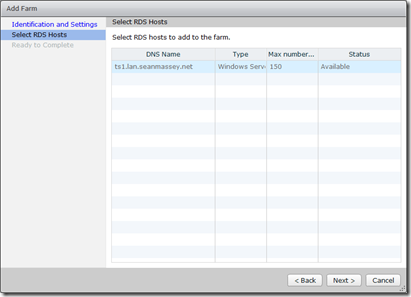The application publishing feature of Horizon 6.0 utilizes the capabilities of the Remote Desktop Session Host role. This requires servers with the role installed and licensed in order to publish applications.
Sizing RDS Servers
There isn’t a lot of guidance from VMware on sizing servers for application publishing. Microsoft guidelines for sizing the Remote Desktop Session Host can be used, though. The Microsoft recommendations are:
- 2 GB of RAM for each CPU core allocated to the system
- 64 MB of RAM for each user session
- Additional RAM to meet the requirements of the installed applications
With these guidelines in mind, a server that has 4 vCPUs and sized for 50 users would need 11 GB of RAM allocated before accounting for additional RAM to support application requirements.
The local system drive should be large enough to accommodate the user profiles for all logged in users, temporary files, and other application data. Drive space should be monitored carefully, and unneeded log, temp, and data files should be cleaned up periodically.
Group Policy Settings
There is a good chance that you will have more than one RDSH server in your application publishing pool. Group Policy should be used to ensure consistent configuration across all servers in the pool. A number of Remote Desktop Services specific policies, such as restricting users to a single session, can only be configured using group policy in Server 2012 R2. Specific Group Policy guidelines for application publishing will be covered in another article.
Building and Deploying A Server
When you’re building up a server image for Terminal Servers, you should consider building up a new server image (or deploy from an existing barebones template), install the Remote Desktop Session Host role, and configure your base applications. This will allow you to quickly deploy RDS servers more quickly than if you would have to build them from scratch and install your business applications on them. This will also require periodic template maintenance to ensure that all of the Windows patches and applications are up to date.
There are already a few good walkthroughs on how to configure a new Windows Server 2012 R2 template, so I won’t cover that ground again. One of my favorites can be found in this great article by Michael White.
While building or deploying your template, it is a good idea to not install any applications until after the Remote Desktop Session Host role has been installed. Applications that are installed before the RDSH role is installed may not work properly.
Once you have your template built, or once you have deployed a new VM from an existing Windows template, we need to take the following steps to prepare the server to publish applications:
1. Connect into the new server using Remote Desktop
2. Launch the Server Manager
3. Click Manage –> Add Roles and Features

4. Click Next to go to the Installation Type screen
5. Select Role-based or feature based Installation and click Next

6. On the Server Selection page, click Next. This will select the server that you’re currently logged into.
Note: It is possible to install and configure Remote Desktop Services remotely using Server 2012 or Server 2012 R2. This can be accomplished using the Server Manager.
7. Check the box for the Remote Desktop Services role and click Next

8. Expand the .Net Framework 3.5 Features and check the .Net Framework 3.5 (includes .NET 2.0 and 3.0) box to select it.
Note: This step is not required for installing the RDSH role. I like to install this feature now, before adding the RDSH role, because many applications still require .Net 3.5.

9. Scroll down to User Interfaces and Infrastructure and expand this list.
10. Check the box next to Desktop Experience. and click next.
Note: Desktop Experience is not required.
11. Click Next to go to the Remote Desktop Role Services page.
12. Check the checkbox for Remote Desktop Session Host. If prompted to install additional features, click Add Features and click Next to continue.

13. Click Install to being the Role and Feature installation.
14. Reboot the server when the installation has finished.
15. Once the installation is complete, open a Command Prompt as an administrator and enter: change user /install . This command puts the RDSH server into software installation mode.

16. Install any business or end-user applications. Once you have completed installing any applications, enter: Change User /Execute.
Installing the Horizon Agent
The last step is to install the Horizon View Agent onto the Remote Desktop Services host. The process for installing the agent is similar to installing it on a desktop virtual machine, but there are some differences in this process.
The steps for installing the View Agent are:
1. Double click the installer to launch it.
2. Click Next on the Welcome screen.

3. Accept the license agreement and click Next.

4. Select the options that you want to install and the directory to install to and click Next.

5. Enter the Fully Qualified Domain Name or IP address of a Connection Server in your environment in the textbox labeled Server.
If the account that you’re logged in with has permission to add the server to the View environment, select the “Authenticate as Current User” option, otherwise select “Specify Administrator Credentials” and provide an account with the correct permissions. Click Next to continue.

6. Click Install to install the View Agent.

7. Click Finish when the installation has completed.

8. The server will prompt for a reboot. Click Yes to reboot the server.

The agent will be completely installed when the reboot completes. But the server will not be available in Horizon View just yet. Before it can be used to publish applications, a Farm and an Application Pool need to be configured.
In the next post, we’ll go over how to set up a Farm inside of View Administrator.






























You must be logged in to post a comment.